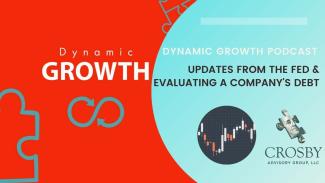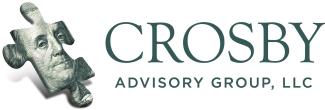
Updates From the Fed and Evaluating a Company's Debt
Have you ever watched something happen and it almost feels like it’s in slow motion? You know what’s going to happen but there’s really nothing you can do to change the course. Sound familiar? It’s exactly how we feel when it comes to the market and listening to the most recent earnings reports from major retailers was yet another example of the bear market at work.
The Latest Fed Meeting
In the most recent Fed meeting, the message was clear – continue with the status quo. As we watch the controlled demolition of the stock market transpire, we can’t help but remind ourselves that this was the plan. The Fed has stated they want to tame inflation by slowing down the economy through interest rate increases. The tone has changed from the last time the Fed met, however, with a new emphasis on raising interest rates until prices stabilize to 2% of inflation or until something breaks.
We’ve said it before but keep in the back of your mind that 8 out of the last 9 times this situation has occurred since 1961, the Fed took the same approach to tame inflation using interest rates and it resulted in a recession. We’re not saying this plan won’t work, we’re just using history as a data point as we prepare for what’s ahead.
Summary of the Numbers
Let’s just say that our eyes are still trying to adjust to all the red. On May 18thth, at the time the podcast was being recorded, the S&P 500 was down 3.35% and the NASDAQ was down 4.14%. The Fed started tightening things earlier this year but it’s now hitting the market – especially retailers. Walmart missed analyst expectations and Target had a huge double digit miss on earnings per share. Revenue is not the issue, but profits are taking a hit as costs are increasing and their debt is more expensive.
Today the VIX is hovering around 28. Remember, the VIX predicts volatility over the next 30 days and if it’s above 20 then it’s higher than normal. The interesting thing is that, yes, 28 is elevated but it’s much lower than we would expect in a bear market. Why? As far as we can see, wild panic selling hasn’t happened. The reason can be anyone’s guess but perhaps it’s because this market downturn was telegraphed so people were ready for it or maybe people have been here before and they understand that downturns are part of investing. No matter the reason, it’s an interesting phenomenon to watch.
A word of caution as we ride the latest market cycle downward, it’s important to remember that the stock market doesn’t care about the time horizon or your feelings for that matter. Look at 1991-2000 where we had a decade of market growth! The market doesn’t have one of those daily tear-away calendars and on day 99 the message is hey time to head back up, but in fact the environment will dictate when the time is up.
What’s Next for You, What’s Next for Us
Our advice: fight the bear market at your own peril! We do have a couple tips for evaluating companies and stocks. These are valid if the market is up or down, but we think it’s a good time to share them.
- Companies: be on the lookout for companies that are still producing earnings, still have strong demand for their products, and have strong balance sheets. Focus on the fundamentals of the company and not so much the stock price. These are good candidates for your portfolio over time.
- Evaluating a stock: take a good look at the income statement for an account you are invested in. In particular, look at the interest expense (expense paid on its debt) and use this to compare against their competitors. A value investor should look for 15% or less of their operating income. Here’s an example:
- P&G is in a healthy position with interest expense at about 6.2% of their operating income
- Bear Stearns (circa 2006), on the other hand, was reporting interest expense of 230% of its operating income in November 2007. As an investor, that would have been a good clue to get out.
These methods can be helpful when comparing two competitors (Home Depot vs Lowes, Apple vs Google) to see if one has a durable advantage. Remember, interest expense can be hidden in booms, but when a downturn happens, these companies may be hit hard.
What is our plan? We work to control risk during the boom and when cycles changeover we will be ready with cash. We’ve added the commodities index to our portfolio, and we have a healthy position of gold. The energy sector has done pretty well and we’re looking at agriculture next. Have you read anything about the possibility of a global food shortage? If not, Lyn Alden’s newsletter is worth the subscribe!
Crypto Hype
Word to the wise, if you’re holding any cryptocurrency consider using cold storage. With recent news hitting hard on Terra LUNA, holders are reminded that companies like Coinbase aren’t FDIC insured and therefore don’t have an obligation to refund you in the case of bankruptcy for example. Hard wallet – yes, please!
So why is Bitcoin so closely related to the stock market? Last year, Bitcoin was a trillion-dollar asset and now it’s currently valued at around 500-600B. A lot of that money is coming from large institutional investors with mandates on how their clients allow them to take on risk with their money. The investor profile is no longer all retail investors buying it for a long-term investment. During a bull market institutional investors have a larger appetite for “risk-on” assets like tech stocks with high valuations or new technology like cryptocurrency. During a bear market, large money managers look to protect capital so they sell the riskiest parts of their portfolio first, a lot of them view Bitcoin as highly speculative and risky. Large money managers dictate where the market goes in the short term, so that's why we see correlation in stocks and Bitcoin.
Please note: This content is not a direct recommendation for investment. Investing involves risk including the potential loss of principal. Not all investments are suitable for all people. Crosby Advisory Group, LLC is a registered investment advisor in Ohio, Florida, and Texas.

